The ASUS ZenPad S (Z580CA) Review
by Brandon Chester on August 31, 2015 8:00 AM ESTBattery Life
The first generation of the iPad promised a ten hour battery life, which was exceptional when one considers what the battery life of smartphones and laptops was at that time. Since that time the battery life target OEMs aim for with tablets has usually hovered around that 10 hour mark. Whether or not a tablet lasts that long obviously depends on a mixture of the user's workload and the OEM's honesty in the battery numbers they report. As for the ZenPad S Z580CA, its 15.2Wh battery is rated for up to 8 hours of battery life by ASUS, which is lower than I would expect when the iPad Mini 2 is competing at the same price with a 10 hour battery life. Of course, the ZenPad S is 0.9 thinner at its thinnest point, which leaves less room to put in battery. This may be one of the cases where I would agree that a thicker device with a larger battery would be better, but that will depend on the outcome of our battery tests.
As always, all devices are calibrated to 200nits for all battery benchmarks, and they follow the standard order of web browsing, BaseMark OS II, PCMark, and finally GFXBench 3.0.

In our WiFi web test the ZenPad S falls about 43 minutes short of its rated 8 hour battery life. Had it been designed for a 10 hour rating this wouldn't be a huge deal as you'd still be talking about nearly 9.2 hours of battery life. However, 7.18 hours is a relatively short battery life for web browsing when you consider that the iPad Mini 2 lasts 9.83 hours in the same test, while the Dell Venue 8 7840 lasts 9.59 hours with the same SoC and a similar display area.
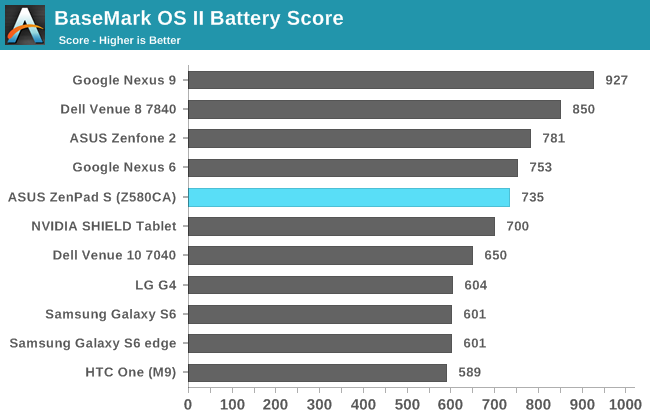

The ZenPad S does fairly well in BaseMark OS II's battery benchmark which mainly stresses a device's CPU. However, it's again outclassed by the Dell Venue 8 7840 which uses the same SoC and actually has a thinner chassis. In this case I would say that the ZenPad S doesn't have bad battery life at all, but I do wish it was a bit higher than it is.
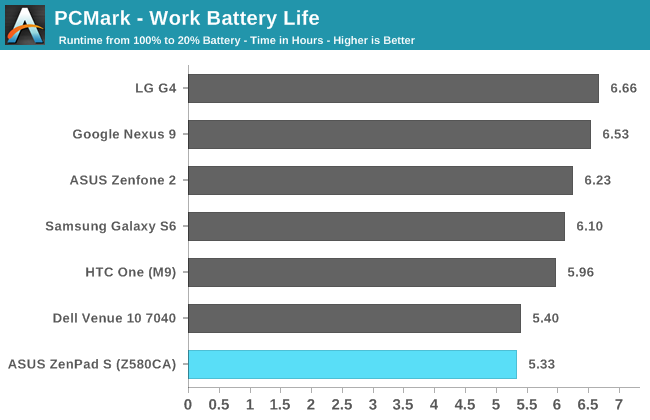
The ZenPad S achieves the shortest battery life of our tested devices in PCMark's battery life test. Although both devices are close, its battery life is slightly shorter than that of the Dell Venue 10 7040, which I repeatedly noted as having extremely poor battery life. PCMark is a fairly good example of the battery life that a user can expected from a mixed workload, and the ZenPad S Z580CA's battery life of 5.33 hours is not quite where it needs to be.
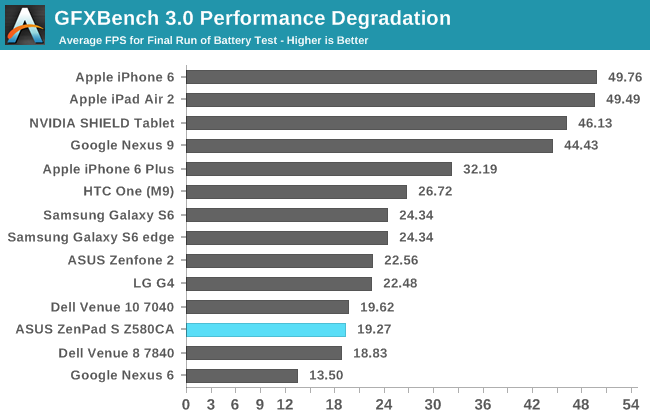
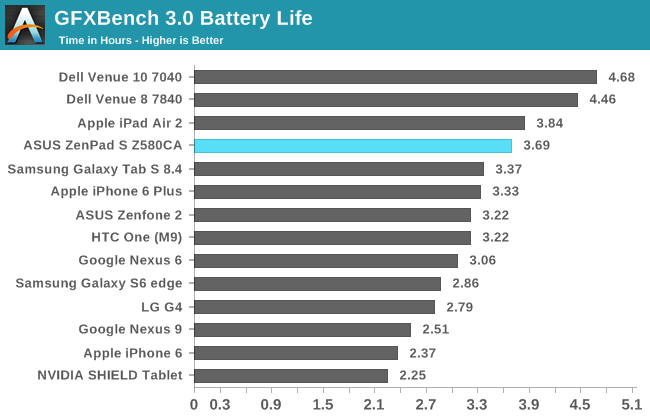
The ZenPad S doesn't last quite as long as the iPad Air 2 in GFXBench's battery test, and sits a little more than 46 minutes behind the Dell Venue 8 7840. Evaluating how well a device does in GFXBench requires considering both the battery life as well as the performance. A device can last a long time but deliver performance that isn't even remotely playable. Conversely, a device can last a short time but have incredible performance, which would still be preferable to a long period of unplayable performance.
With a steady frame rate slightly above 19 FPS for most of the test, the ZenPad S doesn't quite offer smooth performance during the 3.69 hours that it ran for. In comparison, Apple's iPad Air 2 lasted longer and approaches upon 50 FPS, which is well above the 30 FPS that many 3D mobile games target. However, it's also worth noting that this is an on-screen test, and in games that render below a device's native resolution it's entirely possible that the ZenPad S would deliver smooth performance while maintaining its 3.69 hours of battery life. It's also worth noting that the iPad Air 2 costs significantly more than the ZenPad, and while we don't have information about the iPad Mini 2 in this test, it's very likely that its performance would be similar. In the end, the PowerVR G6430 GPU is still a fairly capable GPU, even if it can't run intensive 3D games at 2048x1536. I think the GPU performance and battery life in GPU heavy loads that the ZenPad S offers is more than acceptable for a $300 device.
Charge Time
Since tablets have significantly larger batteries than smartphones, they have always required high power chargers to recharge their batteries in an acceptable period of time. Even so, devices like the 2012 iPad took as long as six hours to charge even with a 10W charger due to the sheer size of their battery. Thankfully, reductions in platform power have allowed for smaller batteries while maintaining battery life, which leads to shorter charging times for tablets. At the moment, most tablets seem to take between 3.5 and 4 hours to charge, and with its 15.2Wh battery one would hope that the ZenPad S could go below that 3.5 hour figure. As you can see above, the ZenPad S doesn't quite meet that goal.
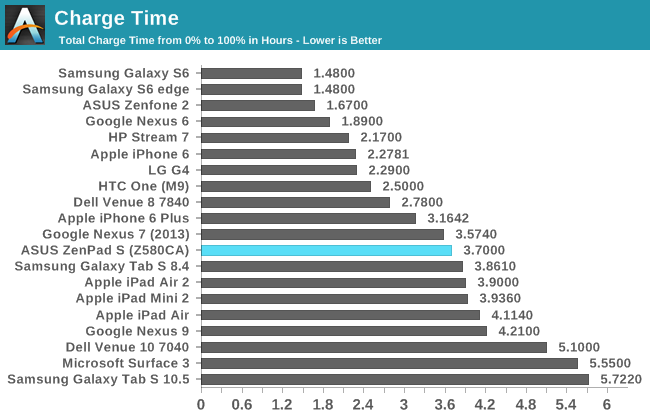
The ZenPad 2 charges slightly quicker than other tablets like the iPad Air 2, iPad Mini 2, Nexus 9, and the Galaxy Tab S 8.4. However, it doesn't charge as fast as the Dell Venue 8 7840. To be honest, I had expected a better result here because of the ZenPad's relatively tiny battery capacity. Dell's included charger provides 7W of power, which isn't as much as the 10W+ bricks that come with iPads and some other tablets. It's worth noting that I also checked the charge time when using ASUS's 18W QC 2.0 power brick, but measured no difference from the one that comes in the box. I would like to note that the lack of QC 2.0 support has absolutely nothing to do with the use of the USB Type-C connector. The USB connector is unrelated to the data and power protocols.
In the end users won't be getting a significant shorter or longer charge time than other tablets, but knowing that the battery is only 15.2Wh has me feeling a bit let down that the ZenPad S takes as long as it does to charge.


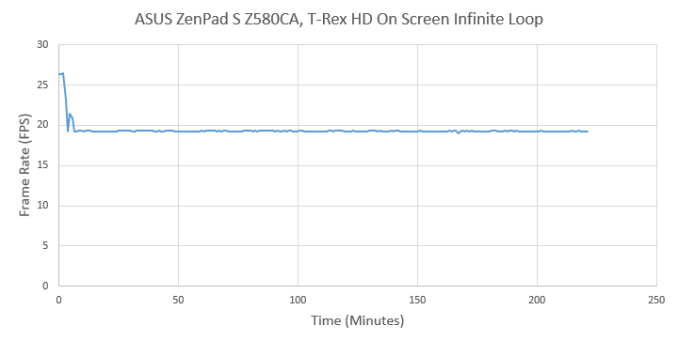








114 Comments
View All Comments
jjj - Monday, August 31, 2015 - link
You guys are out of touch. 300$ for what is a midrange tablet? -with misguided AR and horrible design but lets put that aside. This would have been high end 3 years ago. At 40% lower prices it would be ok-ish - at lest for Apple users that got used with the irrational 4:3 AR and are in love with how briefcases used to look 30 years ago. Odd niche to address but w/e.PC OEM mentality, just dropping parts in a box. They aren't selling lettuce, they are supposed to be in tech and do much better than nothing. They just need to gift wrap some parts together and that's somehow way too difficult for them. They sell out to Intel, they use no neurons in product design and then they whine that the tablet market is not doing well. And that's not just Asus but Asus at least used to be slightly better than others.
boeush - Monday, August 31, 2015 - link
What's so misguided about 4:3 AR? It's basically the same as the standard 8.5" x 11" paper sheet. It's close to the AR of a typical book. It's pretty great for consuming text-based or text-heavy media (hello - Internet?), or just scribbling on for kicks and doodles (or notes). Only thing its not perfect for is movie watching, but who watches movies on a tiny friggin' tablet screen - unless one's desperate?BugblatterIII - Monday, August 31, 2015 - link
4:3 is way better for everything apart from movies. It was one of the main reasons my last tablet was an iPad rather than another Android. I'm glad there are now some Android options.ddriver - Monday, August 31, 2015 - link
Not really.Aside from multimedia, widescreen is better for gaming - more immersive, and also for professional software, where in most cases the UI revolves around a hefty side bar and a central viewport. Having a 4:3 screen means you either lose your viewport or your sidebar.
Honestly, the sole upside to 4:3 might be text editing, but flip a widescreen at 90 degree and suddenly 4:3 is not that much of an attractive prospect.
The only reason people like 4:3 is because apple is still stuck there, and those people are apple fanboys who care not about usability but to be exemplary corporate zealots.
ddriver - Monday, August 31, 2015 - link
The one thing 4:3 is really good for is browsing poorly designed websites. That's about it... If that's what your computing routine boils down to - go for it.BillyONeal - Monday, August 31, 2015 - link
As a Nexus 7 and Surface owner, can confirm 16:9 is garbage for anything but movies.FunBunny2 - Monday, August 31, 2015 - link
Yeah, but *computing* is so 1990s. All these devices are primarily entertainment vehicles. In due time, may be less than a year, there'll be a 16:9/10 watchy thingee so you can consume "Straight Outta Compton" on the way to your cubicle.cwolf78 - Tuesday, September 1, 2015 - link
As another Nexus 7 owner, I agree wholeheartedly. I will not be purchasing another 16:9 tablet. The shape is just too awkward for anything other than movies which I can't stomach watching on a tablet in the first place.BurntMyBacon - Thursday, September 3, 2015 - link
I'm also a Nexus 7 owner and I think the shape is perfect. Its just narrow enough to fit in my pocket. Wait, you want to actually use the device. Whaat?BugblatterIII - Monday, August 31, 2015 - link
So anyone who disagrees with your opinion is an Apple fanboy and/or mostly browses lousy websites?I don't like Apple; I reluctantly bought an iPad because it was the best choice for me at the time.
I have a 24" 16:10 monitor. I always use it in portrait. For videos and games I use my TV. It's a very nice set up and meets my needs perfectly.
If ever you want to have your views taken seriously then you need to be less dismissive of the views of others.